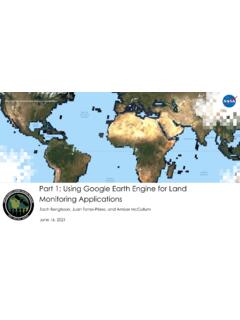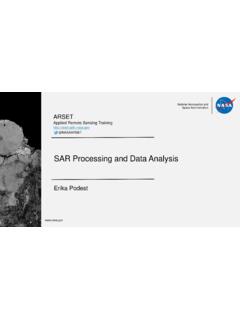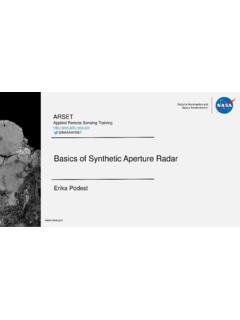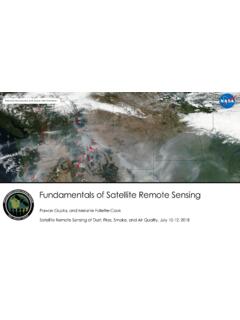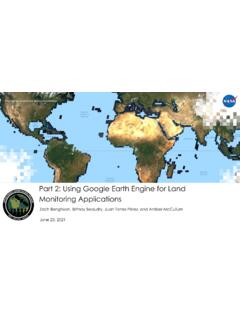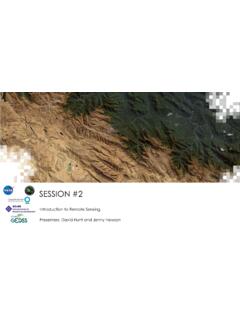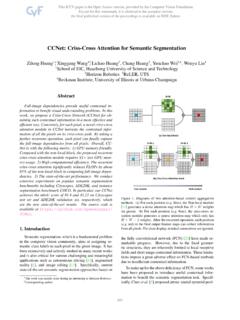Transcription of Part 3: Using Google Earth Engine for Land Monitoring ...
1 National Aeronautics and Space AdministrationZach Bengtsson, Juan Torres-P rez, and Amber McCullumJune 30, 2021 Part 3: Using Google Earth Engine for Land Monitoring Applications2 NASA s Applied Remote Sensing Training ProgramCourse Structure and Materials Three 2-hour sessions on June 16, 23, & 30 Sessions will be presented once in English 12:00-14:00 EDT One Google Form homework due on July 14 Webinar recordings, PowerPoint presentations, and the homework assignment can be found after each session at: Q&A following each lecture and/or by email at: s Applied Remote Sensing Training ProgramWebinar AgendaPart 1: Google Earth Engine Basics & General ApplicationsPart 3: Time Series Analysis & Change DetectionPart 2: Land Cover Classification & Accuracy Assessment4 NASA s Applied Remote Sensing Training ProgramPart 3.
2 Time Series Analysis & Change DetectionWebinar AgendaJuan Torres-P rezZach BengtssonAmber McCullum5 NASA s Applied Remote Sensing Training ProgramSession Outline Time Series Analysis and Change Detection Overview Time series and change detection basics Common time series and change detection methods Techniques for time series analysis and change detection in GEE GEE Code Editor Activity Landsat data retrieval and imagery preparation Vegetation index time series analysis and data visualization Change detection Using visual inspection and image differencing Question & Answer SessionTime Series Analysis and Change Detection Overview7 NASA s Applied Remote Sensing Training ProgramTime Series Analysis with Satellite Imagery Using satellite imagery to monitor landscape change continues to improve with data availability and access to imagery processing platforms Availability of long term satellite data sets Landsat (40+ years) MODIS (20+ years) Increased computing power and cloud computing platforms (like GEE) Improved processing methodsStack of Landsat images of AustraliaImage credit: Data s Applied Remote Sensing Training ProgramTime Series Analysis Basics Time series analysis looks at landscape change as a dynamic process over a number of months, years, and so on.
3 Mapping the environment at various timescales can provide information about land Monitoring parameters like land cover change trends and patterns in vegetation growth. Common uses for a time series approach include: Identifying urban expansion Mapping deforestation Monitoring post-fire conditions 1989199920092019In the summer of 1988, lightning- and human-ignited fires consumed vast stretches of Yellowstone National Park. NDVI estimates over the course of 30 years show increase in greenness, indicating vegetation regrowth across the burn Credit: NASA9 NASA s Applied Remote Sensing Training ProgramImagery Collection Time and Dates for Time Series Analysis Images should be collected at about the same time of day to reduce differences in sun angle Ideally, images from different years should be within the same month or season to avoid seasonal and phenological differences Differences in vegetation greenness Be aware of different annual weather conditions For example, drought years vs.
4 Non-drought yearsAug 1999 Aug 2000 Aug 2001 Aug 2002 Aug 2003 NDVI Anomalies in the southwestern United States. Image Credit: NASA/Goddard Space Flight Center Scientific Visualization Studio. 10 NASA s Applied Remote Sensing Training ProgramTypes of Time Series Analysis Annual vs. seasonal trends Gradual vs. abrupt changes Anomalies Environmental Descriptors/ParametersSatellite forest Monitoring in Canada. Image credit: Foundry Spatial11 NASA s Applied Remote Sensing Training ProgramAnnual Trends Annual Trends Assessment completed yearly, but for as many years as necessary Number of years usually data limited Useful for mapping annual land cover/land use changes over long time periods Example: Annual time series of land use/land cover in the Yangtze River estuary regionAnnual time series of LULC maps of the Yangtze River estuary region from 1985 to : Ai et al.
5 202012 NASA s Applied Remote Sensing Training ProgramSeasonal Trends Seasonal Trends Driven by annual temperature and/or precipitation Variation between seasons Can measure change within a year timeframe Useful in comparison of seasonal variation between years Example: Snow cover Monitoring in the HimalayasSeasonal snow cover based on MODIS snow cover time series from Mar 2000 to Feb 2008. (Winter, (top), Spring, Summer Autumn (bottom). The values show the percentage of time that a pixel was snow-covered during the season within the time s Applied Remote Sensing Training ProgramGradual vs. Abrupt Changes Gradual changes: Insect infestation in forests Land degradation Forest recovery Abrupt changes: Wildfire Deforestation Urban development Example: Forest recovery after wildfire in Yellowstone National ParkChanges in NDVI values between 1986 and 2006 for one site in Yellowstone National ParkCredit: Franks, Masek, & Turner 2013 14 NASA s Applied Remote Sensing Training ProgramAnomalies Relative difference from a long term average Example: FAO Global Normalized Difference Vegetation (NDVI) AnomaliesImage Credit.)
6 Food and Agriculture Organization of the United Nations15 NASA s Applied Remote Sensing Training ProgramEnvironmental Descriptors/Parameters Use time series of satellite observations to derive environmental descriptors/ parameters as proxies for environmental conditions on the ground Example: Dynamic Habitat Indices (DHIs) use time series of satellite observations of greenness to describe vegetation dynamics to understand bird species richness Vegetation dynamics include: productivity, minimum level of perennial cover, degree of vegetation seasonalityDynamic Habitat Indices derived from MODIS GPP 2003-2014 data (a) cumulative DHI; (b) minimum DHI; (c) variation DHI; (d) combined : Hobi, et al. 201716 NASA s Applied Remote Sensing Training ProgramTime Series Analysis in GEE GEE has a variety of functions useful for time series analysis: Filtering and compilation of data across large datasets over time Analysis Using map visualizations and user interface generated charts and graphsExample chart of time series NDVI data from MODIS plotted in GEE from 2010 to 2019.
7 Image Credit: GEE Developers17 NASA s Applied Remote Sensing Training ProgramTime Series Analysis in GEE: LandTrendr Landsat-based detection of Trends in Disturbance and Recovery Temporally segments a time-series of images by extracting the spectral trajectories of change over time Use of LandTrendrin Google Earth Engine simplifies pre-processing steps and can make implementation of the algorithm easier LandTrendrin GEE Guide: year of disturbance maps derived from LT-IDL and LT-GEE algorithms. Maps show the year of detected forest disturbance, filtered to 11 pixels minimum mapping unit for an area of the western Cascade Mountains in Credit: Kennedy et al. 201818 NASA s Applied Remote Sensing Training ProgramChange Detection Basics The conversion of a landscape from one dominant feature type to another Examples: Changes in tree cover due to wildfire or deforestation Urbanization Land degradation due to over grazing Information that can be derived from satellites: Where and when has change taken place?
8 How much and what kind of change has occurred? What are the cycles and trends in the change?UrbanSuburbanMapping of urbanization in Ulaanbaatar, Mongolia from 2001 to Credit: NASA EO19 NASA s Applied Remote Sensing Training ProgramCharacterizing Landscape Change Types of Change Directional change Example: urban development Cyclic change Example: seasonal phenology Multidirectional change Example: deforestation and forest regeneration Broad Categories of Change Change in shape or size of patches of land cover types (urbanization) Slow changes in cover type or species composition (succession) vs. abrupt land cover transitions (wildfire and deforestation) Slow changes in condition of a single cover type (forest degradation due to insect or disease) Changes in timing of extent of seasonal processes (drought Monitoring )20 NASA s Applied Remote Sensing Training ProgramChange Detection Using Remote Sensing Changes on the landscape can be detected as changes in the spectral values of pixels We can use spectral signatures to differentiate between cover types and calculate environmental indices Example pre-fire and post-fire conditions.
9 Healthy vegetation has high reflectance in the green and near-infrared but low in the short-wave infrared Burned areas have low reflectance in the green and near-infrared but high in the S short-wave infraredExploiting Spectral Response CurvesHealthy vegetation has a large peak in the near infrared, while soil or burned areas are much lower. Healthy vegetation also has low reflectance in the shortwave infrared, while burned areas have high reflectance . 21 NASA s Applied Remote Sensing Training ProgramDifferenced Normalized Burn Ratio Compare pre-and post-burn images to identify burn extent and severity with a differenced mapdNBR= NBRprefire- NBRpostfireNBR = (NIR SWIR2)NIR + SWIR222 NASA s Applied Remote Sensing Training ProgramChange Detection Goals Identification of the geographical location and types of changes Quantification of changes Assessment of the of the change detection results Identifying the location of and quantifying change is easier than identifying the cause of imagery of Saudi Arabia used to map agricultural growth.
10 Credit: NASA23 NASA s Applied Remote Sensing Training ProgramChange Detection Considerations Change detection requires multi-temporal datasets When selecting multi-temporal remote sensing data it is important to use: The same sensor The same spatial resolution Data from the exact same or similar times of day, days of the year, and/or seasons Data that is nearly cloud free Radiometrically and atmospherically corrected data It s important to keep these factors in mind, because you need to minimzechanges due to data characteristics you are not interested in, so that you can identify the changes you are interested s Applied Remote Sensing Training ProgramChange Detection Considerations Between-class changes Answers the question: Has a pixel changed and what has it changed to?
